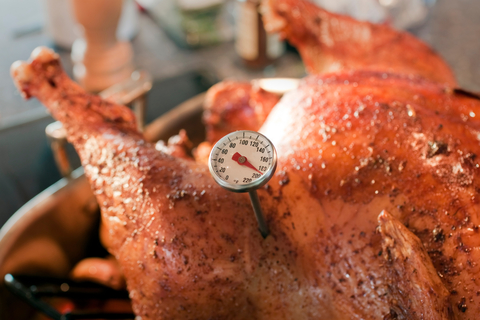Food thermometers help you:
- Cook food to a safe temperature.
- Prevent overcooking and get the best flavor.
- Hold and store foods safely.
Use a food thermometer every time you cook or reheat to tell if your food is safely cooked. You can't tell if a food is safely cooked simply by checking its color or texture.
See the Safe minimum internal temperature chart for cooking from FoodSafety.gov for guidelines on how to cook raw meat, poultry, seafood and other foods to a safe minimum internal temperature. Always use a food thermometer to check whether meat has reached a safe minimum internal temperature that is hot enough to kill harmful germs that cause food poisoning.
How to use a food thermometer
A dial instant-read thermometer is designed for quick temperature reading.
- Insert the stem until the notch on the side is covered.
- For whole-muscle meats or poultry, insert into the thickest part without touching bone.
- For mixed dishes or casseroles, insert the stem until the notch is covered.
- The temperature should register in about 15 to 20 seconds.
- Insert sideways into thin foods like hamburgers and chicken breasts.
- Wash the stem with soapy water after each use.
How to check the accuracy of a food thermometer
Dial thermometers should be checked periodically. Follow the manufacturer’s recommendations.
Ice water method to check thermometer accuracy:
- Fill a large glass with crushed ice.
- Add water to the top of the ice and stir well. Let stand for 3 minutes.
- Place the thermometer stem at least 2 inches into the ice water.
- The thermometer should read 32˚F after 30 seconds.
To calibrate: Turn the calibration nut under the dial until the thermometer dial registers 32˚F and re-test.
How to use a refrigerator thermometer
Refrigerator thermometers are used to check refrigerator temperatures.
- Refrigerator temperature should be at 37˚ to 40˚F.
- Place the thermometer in the front, near the refrigerator door.
- If the temperature is higher than 40˚F, adjust the refrigerator control dial or setting.
Reviewed in 2023


